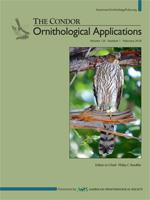Cooper's Hawks (Accipiter cooperii) have been extending their breeding range into urban areas, prompting questions about the relative importance of cities to the demography and conservation of these raptors. A key unanswered question is how urban subpopulations interact with their precedent exurban subpopulations. Two general models have been proposed to describe relationships among subpopulations in a metapopulation: (1) source–sink, where immigrants from sources sustain sinks; and (2) balanced dispersal, where dispersal is proportionally equal among subpopulations. I evaluated whether either of these models predict metapopulation dynamics of urban and exurban Cooper's Hawks in central New Mexico using demographic data in a Bayesian integrated population model. All urban female Cooper's Hawks began breeding in their first year; 69% settled at nests in the urban subpopulation and 31% emigrated and settled in an exurban subpopulation. The high rate of female emigration was likely because of a shortage of breeding urban males, caused by a 1 yr delay in male age-at-first-breeding. Emigration exceeded immigration by nearly 30%, making a balanced-dispersal model implausible. Although the urban subpopulation was a source, the primary recipient subpopulation was not a sink; urban emigrants appeared to have a competitive advantage obtaining exurban nest sites. High urban winter prey abundance supported year-long residency among urban female Cooper's Hawks, whereas nearly all exurban females migrated. Resident urban females that emigrated settled on exurban nesting territories before migrants returned, and thus without direct competition from them. Previous metapopulation models do not incorporate the concept that differences in dispersal behavior between subpopulations can drive dispersal dynamics in a metapopulation. These findings provide further evidence that patch dynamics in a metapopulation can be complex, and may be governed by factors other than just demographic rates and connectivity.
How to translate text using browser tools
13 December 2017
Demography and metapopulation dynamics of an urban Cooper's Hawk subpopulation
Brian A. Millsap

The Condor
Vol. 120 • No. 1
February 2018
Vol. 120 • No. 1
February 2018
Accipiter cooperii
balanced dispersal model
Bayesian integrated population model
Cooper's Hawk
metapopulation dynamics
source–sink model
urban wildlife




